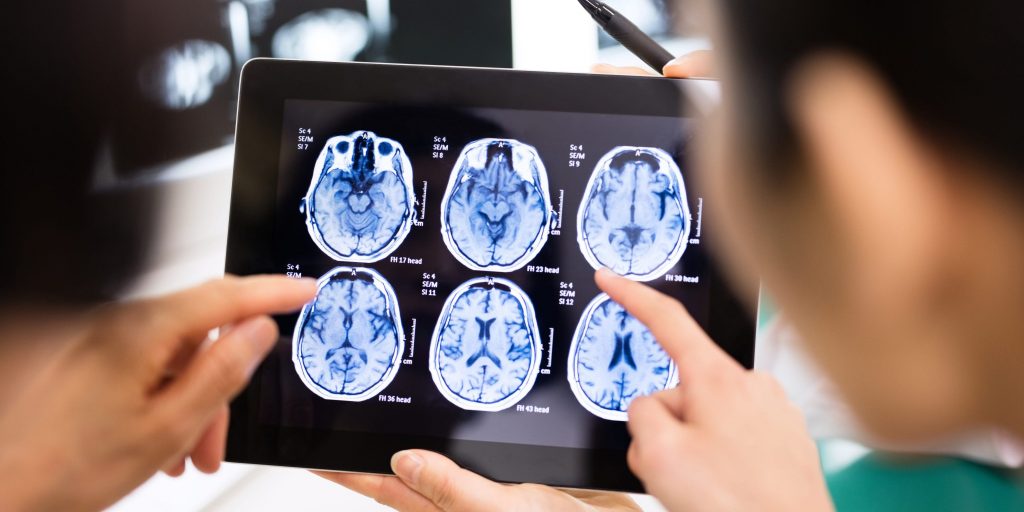
- A seizure occurs when there is abnormal electrical activity in the brain.
- There are different types of seizures depending on where and how much brain activity is affected.
- If someone is seizing make sure to roll them on their side and record how long the episode lasts.
- Visit Insider's Health Reference library for more advice.
Seizures occur when the normal electrical activity in your brain is disrupted. This can lead to symptoms like unconsciousness, uncontrollable shaking, or lip-smacking.
Your symptoms largely depend on what area of the brain is affected. For example, if the part of your brain responsible for movement is affected, then your muscles might tense up.
About one in ten people will experience at least one seizure in their lifetime, and the seizure will usually last anywhere from 30 seconds to two minutes.
However, not all seizures are the same. Different types of seizures can affect one or all areas of the brain for varying durations, which causes different symptoms.
Below are six different types of seizures, explained and a guide on what to do when someone is having a seizure.
1. Focal seizure
A focal seizure is when only one part of the brain is affected, says Holly Skinner, DO, a neurologist specializing in epileptology and sleep medicine at AdventHealth.
There are two subtypes of focal seizures, which identify whether, or not, the person loses consciousness:
- Focal impaired awareness seizures: When you lose consciousness or awareness of your surroundings.
- Focal aware seizures: You are alert and able to remember what happened during the seizure, though your emotions and senses may be impaired.
2. Febrile seizure
A fever can trigger febrile seizures in children aged 3 months to 6 years. This type of generalized seizure occurs in about 2% to 5% of children before age 5.
Symptoms include uncontrollable shaking of both arms and legs, stiff limbs, eye-rolling, and loss of consciousness, which usually occur for less than 15 minutes.
Children with prolonged seizures lasting more than 30 minutes have a 30% to 40% risk of developing epilepsy. Moreover, long-lasting seizures, aka status epilepticus, increases the risk of having repeat seizures.
3. Tonic and atonic seizure
Tonic and atonic seizures are types of generalized seizures that affect the muscles, but in different ways.
- Tonic seizures occur when a limb or the entire body stiffens in an instant.
- Atonic seizures mean that a specific region or the entire body experiences a sudden loss of muscle tone and goes limp, says Sarita Maturu, DO, a neurologist at The Ohio State University Wexner Medical Center.
During either a tonic or atonic seizure, individuals may lose awareness or consciousness where they can collapse and potentially hurt themselves. They usually last for about 15 to 20 seconds or less.
4. Clonic seizure
Clonic seizures last for a few seconds to a minute and are characterized by repeated and rhythmic jerking of the neck, face, limbs, or the entire body.
The jerking can happen on just one or both sides of the body depending on how much of the brain is affected. If the entire brain is affected, it's likely that the person may lose consciousness or have an impaired awareness when the seizure occurs.
This type of generalized seizure is more common in babies, but it can affect all age groups.
5. Tonic-clonic seizure (Grand mal)
Tonic-clonic seizures are the new term for what used to be called grand mal seizures.
The new name is more indicative of what they entail: Tonic-clonic seizures include the symptoms of both tonic and clonic seizures:
- First, the muscles stiffen and there is an abrupt change in awareness or loss of consciousness, similar to a tonic seizure.
- Then the limbs jerk rapidly and rhythmically just like during a clonic seizure.
"Some causes of generalized tonic-clonic seizures are due to genetics or from strokes, head injuries, tumors, brain infections, and other inflammatory conditions," says Skinner. "Generalized tonic-clonic seizures typically are rare and can occur at any age, but peak in early childhood or adolescence."
6. Absence seizure (Petit mal)
Absence seizures, previously known as petit mal seizures, are brief periods of loss of awareness that usually last for about five to ten seconds.
It is caused by brief abnormal electrical activity that begins in both sides of the brain where electrical signals repeat themselves over and over, leading to symptoms such as staring into space with a blank look, fluttering eyelids or eyes turning upwards, or lip-smacking.
Absence seizures are common among children ages 4 to 14, and about 70% of children who experience them will outgrow it by age 18. The other 30% may require seizure medication long-term to manage their symptoms.
What to do when someone is having a seizure
It's important to know what to do when you witness someone having a seizure. Here are a few tips to help them:
| DOs: | DON'Ts: |
|
Do cushion their head with something soft, like a pillow or folded jacket. |
Don't try to restrain them or stop their movements. |
|
Do roll them onto one side to help them breathe. |
Don't leave them before medical personnel arrive. |
|
Do protect them by clearing the area of hard or sharp objects that may harm them. |
Don't put anything in their mouth because it can choke or injure them. |
|
Do loosen anything around their neck that may make it hard to breathe. |
Don't try to give them mouth-to-mouth resuscitation. |
|
Do observe their symptoms and time the seizure so you can provide them with details. |
Don't offer them any food or drink until they are completely alert. |
Experts say it's a common misconception that you have to prevent the person having a seizure from swallowing their tongue.
"Putting something in someone's mouth while they are having a seizure can actually lead to choking, and putting your own fingers in someone's mouth could lead to severe injury of your own hand. You cannot swallow your tongue," says Maturu.
Insider's takeaway
Seizures are caused by a sudden electrical disturbance in the brain, which can be triggered by various factors such as high fever, brain tumor, or head trauma. Different types of seizures vary in their clinical manifestations.
If you see a person having a seizure, don't try to stop their movements or put anything in their mouth.
"It's important to remember that seizures are treatable. If someone is having seizures despite taking seizure medication, you should call their doctor immediately and they should be seen at a dedicated epilepsy center," says Skinner.
